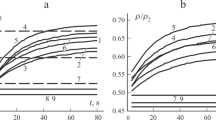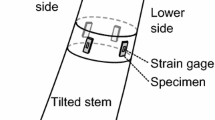Abstract
Viscoelastic Thermal Compression (VTC) of wood is a treatment which greatly improves material properties by means of densification with mechanical compression perpendicular to the grain. VTC is similar to other wood densification processes, but is designed for thin lamina and employs dynamic temperature and steam pressure conditions. A device was constructed that is capable of producing VTC wood. Details of the construction and operation of the VTC device are presented. The device consists of a pressurized chamber with variable volume. Wood density may be modified from the initial density of the virgin wood up to approximately 1400 kg/m3. Control of steam pressure and temperature insures that the wood cell walls are not fractured during the process. The device is designed for batch operation and may be adapted to a conventional laboratory hot-press. An example operating schedule is described, but other procedures are possible within the design parameters of the device.
Zusammenfassung
Viskoelastische thermische Verdichtung (Viscoelastic Thermal Compression – VTC) ist ein Verfahren, das die Materialeigenschaften von Holz mittels Verdichtung quer zur Faserrichtung stark verbessert. Das VTC Verfahren ähnelt anderen Holzverdichtungsverfahren, wurde jedoch für dünne Holzbrettchen entwickelt und nutzt wechselnde Temperatur- und Druckbedingungen. Entwickelt wurde ein Gerät zur Produktion von VTC Holz, dessen Einzelheiten der Konstruktion und des Betriebes hier vorgestellt werden. Das Gerät besteht aus einem Druckbehälter mit veränderbarem Volumen. Dieses Gerät kann Holz ausgehend von der Ausgangsdichte bis zu einer Dichte von 1400 kg/m3 verdichten. Die Steuerung des Dampfdruckes und der Temperatur gewährleistet, dass die Zellwände des Holzes während der Behandlung nicht zerstört werden. Das VTC Gerät wurde für den diskontinuierlichen Betrieb entwickelt und kann in eine Laborheißpresse eingebaut werden. Ein Beispiel eines Betriebsplanes ist hier beschrieben. Das Gerät kann jedoch auch unter Nutzung anderer Systemgrößen betrieben werden, solange die Maximalwerte des Gerätes nicht überschritten werden.






Similar content being viewed by others
References
Gabrielli C, Kamke FA (2008) Treatment of chemically modified wood with VTC process to improve dimensional stability. For Prod J 58(12):82–86
Geimer RL, Kwon JH (1999) Flakeboard thickness swelling. Part II. Fundamental response of board properties to steam injection pressing. Wood Fiber Sci 31(1):15–27
Hsu WE, Schwald W, Schwald J, JA Shields (1988) Chemical and physical changes required for producing dimensionally stable wood-based composites. Part I: Steam pretreatment. Wood Sci Technol 22:281–289
Inoue M, Norimoto M, Tanahashi M, Rowell RM (1993) Steam or heat fixation of compressed wood. Wood Fiber Sci 25(3):224–235
Inoue M, Sekino N, Morooka T, Norimoto M (1996) Dimensional stabilization of wood composites by steaming I. Fixation of compressed wood by pre-steaming. In: Proceedings from the third pacific rim bio-based composites symposium, Kyoto, Japan, pp 240–248
Jarck W (2009) System and method for the manufacture of reconstituted wood products. US Patent No. 7,537,031 B2
Kamke FA (2006) Densified radiata pine for structural composites. MADERAS: Cie Tecnol J 8(2):83–92
Kamke FA, Kultikova EV, Lenth CA (2000) Viscoelastic thermal compression of wood. In Proceedings of the 5th pacific-rim bio-based composites symp, December 10–13, 2000, Canberra, Australia, pp 292–302
Kamke FA, Rathi V (2009) Modified hybrid poplar for structural composites. In: Proceedings of the 4th European conference on wood modification, Stockholm, Sweden, April 27–29, 2009, pp 397–400
Kamke FA, Rautkari L (2009) Modified wood veneer for structural applications. In: Proceedings of the 4th international symposium on veneer processing and products, May 24–27, 2009, Espoo, Finland, pp 207–212
Kamke FA Sizemore H III (2008) Viscoelastic thermal compression of wood. US Patent No 7,404,422 B2, July 29, 2008
Kawai S, Wang Q, Sasaki H, Tanahashi M (1992) Production of compressed laminated veneer lumber by steam pressing. In: Proceedings of the pacific rim bio-based composites symposium, pp 121–128
Kutnar A, Kamke FA, Sernek M (2008) Mechanical properties of densified VTC wood relevant for structural composites. Holz Roh- Werkst 66(6):439–446
Kutnar A, Kamke FA, Sernek M (2009) Density profile and morphology of viscoelastic thermal compressed wood. Wood Sci Technol 43:57–68
Navi P, Girardet F (2000) Effects of thermo-hydro-mechanical treatment on the structure and properties of wood. Holzforschung 54:287–293
Tanahashi M, Inoue M, Fukada S, Ota C, Kimoto S (1994) Wood treating method and apparatus. US Patent 5,343,913
Acknowledgements
Funding for this work was provided by USDA Cooperative State Research, Education and Extension Service, National Research Initiative Grant # 2006-35504-17444, and the JELD-WEN Foundation.
Author information
Authors and Affiliations
Corresponding author
Rights and permissions
About this article
Cite this article
Kamke, F.A., Rathi, V.M. Apparatus for viscoelastic thermal compression of wood. Eur. J. Wood Prod. 69, 483–487 (2011). https://doi.org/10.1007/s00107-010-0461-7
Received:
Published:
Issue Date:
DOI: https://doi.org/10.1007/s00107-010-0461-7




